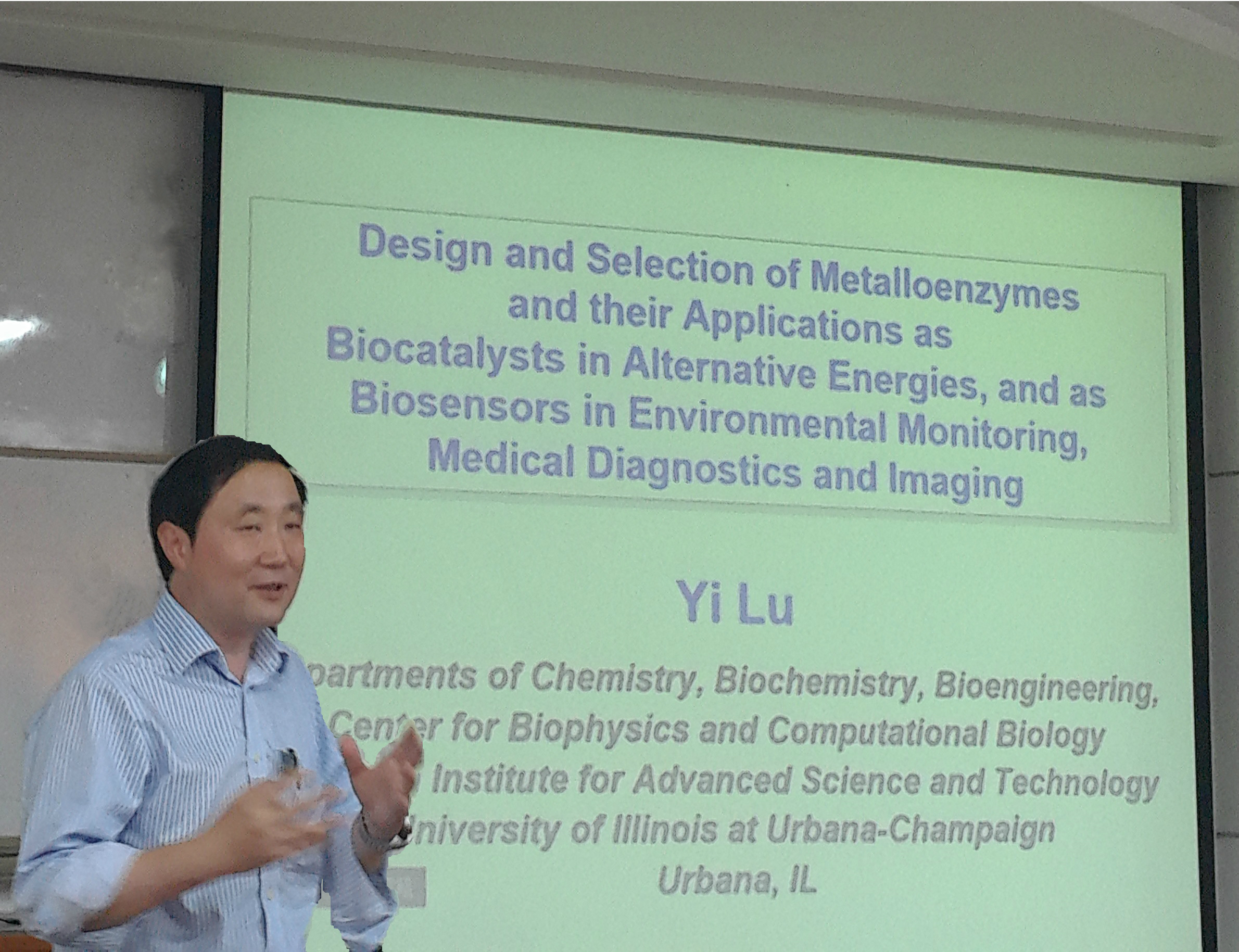On August 5, with the invitation of Prof. Wu Yun-Dong, Prof. LU Yi from Department of University of Illinois at Urbana Champaign visited our School of Chemical Biology and Biochemistry and some of our labs. After having a discussion lunch with ten of our students at the Cooking Fun Cafeteria, he made a splendid talk named “Design and Selection of Metalloenzymes and their Applications as Biocatalysts in Alternative Energies, and as Biosensors in Environmental Monitoring, Medical Diagnostics and Imaging”.
Prof. LU Yi first introduced his research background and areas to us all. The main focus of his research consists of two parts, namely the metalloprotein design as artificial biocatalysts and the DNA/RNA biosensor. He explained to us in detail about these two aspects.
Metalloproteins catalyze difficult reactions with efficiency and selectivity that few other natural or artificial molecules can match. Little has been known about how to design a metalloprotein with desired structure and activity. It is possible to design complex functional metalloenzymes such as CcO using much more simpler native proteins. Proteins of interest include heme-copper oxidase, manganese peroxidase and cytochrome p450. In this way, their group are dedicated into making artificial biocatalysts by incorporating transition metal complexes into proteins. The combination of efficiency of the metal catalysts with the control and selectivity of proteins resulted in a new generation of asymmetric catalysts for synthesis of fine chemicals and chiral drug intermediates.
In fundamental sciences, designing selective sensors/agents based on a single class of molecules for a broad range of targets remains a significant challenge. To meet these challenges, they have been able to use in vitro selection or SELEX to obtain DNAzymes, a new class of metalloenzymes that use DNA molecules exclusively for catalysis, and aptamers, a new class of nucleic acids that rivals antibodies, that can bind targets of choice strongly and specifically, and use negative selection strategy to improve the selectivity. By labeling the resulting DNAzymes and aptamers, called functional DNA with fluorophore/quencher, gold nanoparticles, gadolinium or super magnetic iron oxide nanoparticles, they have developed new classes of fluorescent, colorimetric and MRI agents for metal ions and a wide range of other targets with high sensitivity (down to 14 pM) and selectivity (> 1 million fold selectivity). These sensors have been applied for imaging metal ions and other targets in living cells and in vivo to offer deeper insight into their roles in biology. Besides, Prof. Lu is also involved in the founding of one technological company and cooperates closely with industrial and academic companies for the applications of this new generation of technology. (Written by Zhang Tonghuan)

Profile for the speaker:
Dr. Yi Lu received his B.S. degree from Peking University in 1986, and Ph.D. degree from University of California at Los Angeles in 1992. After two years of postdoctoral research in Professor Harry B. Gray group at the Caltech, Dr. Lu started his own independent career in the Department of Chemistry at the University of Illinois at Urbana Champaign in 1994. He is now Jay and Ann Schenck Professor of Chemistry in the Departments of Chemistry, Biochemistry, Bioengineering and Materials Science and Engineering. He is also a member of the Center for Biophysics and Computational Biology, Beckman Institute for Advanced Science and Technology and Institute of Genomic Biology. His research interests lie at the interface between chemistry and biology. He has received numerous research and teaching awards, among which the latest ones include the Royal Society of Chemistry Applied Inorganic Chemistry Award (2015), Fellow of the Royal Society of Chemistry (2015), the Thomson Reuters Highly Cited Researchers list for 2015.